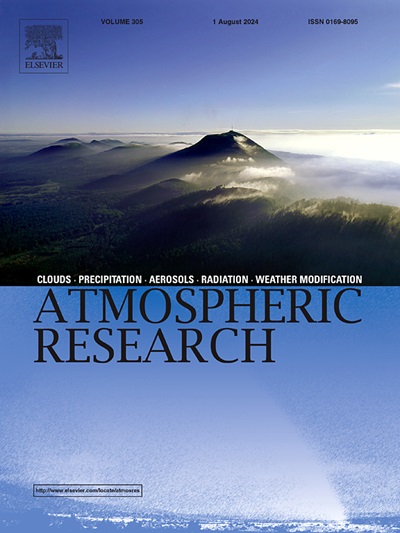评估撒哈拉大沙尘暴的直接辐射强迫
IF 4.4
2区 地球科学
Q1 METEOROLOGY & ATMOSPHERIC SCIENCES
引用次数: 0
摘要
研究了2020年6月在大西洋附近的西撒哈拉沙漠发生的大规模沙漠沙尘爆发所造成的辐射影响。这次爆发的特点是两个重要的尘埃羽流,其中第二个是本研究的重点。本文章由计算机程序翻译,如有差异,请以英文原文为准。

Evaluating the direct radiative forcing of a giant Saharan dust storm
The radiative effects caused by a massive desert dust outbreak that took place in the Western Sahara Desert, in the proximity of the Atlantic Ocean, in June 2020 are studied. This outbreak featured two significant dust plumes, the second of which is the focus of the present study.
For the identification of the dust plume, we adopted a multi-platform set of remote sensing data, including satellite retrievals from the sensors VIIRS, MODIS and SEVIRI onboard the NOAA-20, Aqua and MSG spacecrafts, respectively. The analysis of aerosol-radiation effects is based on a regional simulation with the WRF-Chem model, implementing the coupling between the aerosols of the GOCART speciation and the radiative modules defined in WRF-Chem model by the “New Goddard Shortwave and Longwave Schemes”. In this context, two sets of simulations are proposed: the first one (CTL) without any feedback, and the second (CPL) adopting the fully-coupling strategy.
From the comparison between the simulated and the observed (SEVIRI) incoming SW/LW radiation it follows that: (i) the presence of dust in the domain causes a reduction of the incoming SW radiation in the CPL runs; (ii) this reduction is fully in agreement with experimental data; (iii) conversely, the LW component appears to be insensitive to model coupling. Hence, the Goddard radiative coupling is effective in reducing the incoming SW radiation: the difference in terms of average daily values between model and SEVIRI is 123.7 vs 37.0 W m−2 for CTL and CPL runs, respectively. The incoming longwave radiation seems to be less correlated with the coupling strategy, being the difference of 31.15 vs 15.8 W m−2 for CTL and CPL runs, respectively.
The dust radiative forcing (DRF), that characterises the aerosol–radiation interactions, results in an average surface cooling of −16.9 W m−2 between the CPL and the CTL runs that could be attributed to a reduction of SW radiation absorbed and scattered by dust particles in the coupled run. At the top of the atmosphere (TOA), a warming, caused by the decrease in atmospheric transparency to the terrestrial thermal radiation, results in an average DRF of +1.5 W m−2.
Finally, the space- and time-averaged surface energy balance results in a difference (E(CPL) - E(CTL)) of about −7.5 W m−2. Similarly, the dynamic response of the dust forcing within the Planetary Boundary Layer is characterised by a mean temperature difference (CPL-CTL) of about −0.7 K near the surface.
Our findings strongly encourage the use of fully-coupled modelling strategy, between aerosols and meteorology, for regional-scale studies and in climate risk assessments.
求助全文
通过发布文献求助,成功后即可免费获取论文全文。
去求助
来源期刊

Atmospheric Research
地学-气象与大气科学
CiteScore
9.40
自引率
10.90%
发文量
460
审稿时长
47 days
期刊介绍:
The journal publishes scientific papers (research papers, review articles, letters and notes) dealing with the part of the atmosphere where meteorological events occur. Attention is given to all processes extending from the earth surface to the tropopause, but special emphasis continues to be devoted to the physics of clouds, mesoscale meteorology and air pollution, i.e. atmospheric aerosols; microphysical processes; cloud dynamics and thermodynamics; numerical simulation, climatology, climate change and weather modification.
 求助内容:
求助内容: 应助结果提醒方式:
应助结果提醒方式:


